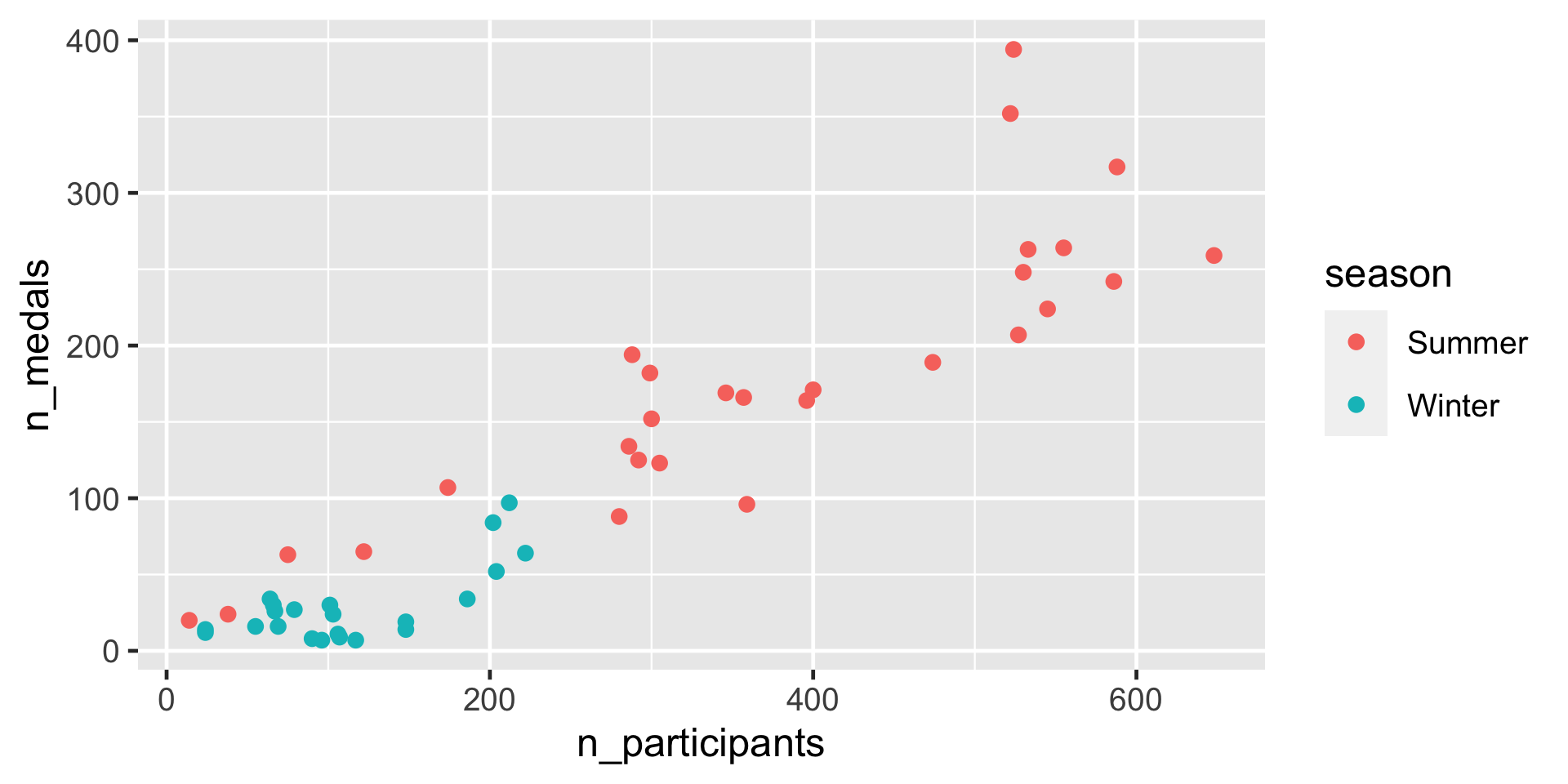Nesting data for modeling
Reshaping Data with tidyr

Jeroen Boeye
Head of Machine Learning, Faktion
USA Olympic performance
usa_olympic_df
# A tibble: 50 x 5
country year season n_participants n_medals
<chr> <dbl> <chr> <int> <int>
1 USA 1896 Summer 14 20
2 USA 1900 Summer 75 63
3 USA 1904 Summer 524 394
4 USA 1906 Summer 38 24
5 USA 1908 Summer 122 65
6 USA 1912 Summer 174 107
# ... with 44 more rows
USA Olympic performance
usa_olympic_df %>%
ggplot(aes(x = n_participants, y = n_medals, color = season))+
geom_point()

Modeling the pattern
model <- lm(n_medals ~ n_participants + 0, data = usa_olympics_df)
model
Call:
lm(formula = n_medals ~ n_participants + 0, data = usa_olympics_df)
Coefficients:
n_participants
0.463
Untidy model statistics
summary(model)
Call:
lm(formula = n_medals ~ n_participants + 0, data = usa_olympics_df)
Residuals:
Min 1Q Median 3Q Max
-70.222 -36.175 -9.554 6.871 151.380
Coefficients:
Estimate Std. Error t value Pr(>|t|)
n_participants 0.46302 0.01791 25.86 <2e-16 ***
--
Signif. codes: 0 '***' 0.001 '**' 0.01 '*' 0.05 '.' 0.1 ' ' 1
Residual standard error: 40.17 on 49 degrees of freedom
Multiple R-squared: 0.9317, Adjusted R-squared: 0.9303
F-statistic: 668.5 on 1 and 49 DF, p-value: < 2.2e-16
The broom package
broom::glance(model)
# A tibble: 1 x 11
r.squared adj.r.squared sigma statistic p.value df logLik AIC BIC deviance df.residual
<dbl> <dbl> <dbl> <dbl> <dbl> <int> <dbl> <dbl> <dbl> <dbl> <int>
1 0.932 0.930 40.2 668. 3.25e-30 1 -255. 514. 518. 79079. 49
broom::tidy(model)
# A tibble: 1 x 5
term estimate std.error statistic p.value
<chr> <dbl> <dbl> <dbl> <dbl>
1 n_participants 0.463 0.0179 25.9 3.25e-30
broom + dplyr + tidyr
usa_olympics_df %>%
group_by(country) %>%
nest()
# A tibble: 1 x 2
# Groups: country [1]
country data
<chr> <list>
1 USA <tibble [50 × 4]>
Nested tibble & purrr::map()
usa_olympics_df %>%
group_by(country) %>%
nest() %>%
mutate(fit = purrr::map(data, function(df) lm(n_medals ~ n_participants + 0, data = df)))
# A tibble: 1 x 3
# Groups: country [1]
country data fit
<chr> <list> <list>
1 USA <tibble [50 × 4]> <lm>
Working with nested tibbles
usa_olympics_df %>%
group_by(country) %>%
nest() %>%
mutate(fit = purrr::map(data, function(df) lm(n_medals ~ n_participants + 0, data = df)),
glanced = purrr::map(fit, broom::glance))
# A tibble: 1 x 4
# Groups: country [1]
country data fit glanced
<chr> <list> <list> <list>
1 USA <tibble [50 × 4]> <lm> <tibble [1 × 11]>
Unnesting model results
usa_olympics_df %>%
group_by(country) %>%
nest() %>%
mutate(fit = purrr::map(data, function(df) lm(n_medals ~ n_participants + 0, data = df)),
glanced = purrr::map(fit, broom::glance)) %>%
unnest(glanced)
# A tibble: 1 x 14
# Groups: country [1]
country data fit r.squared adj.r.squared sigma statistic p.value df
<chr> <list> <list> <dbl> <dbl> <dbl> <dbl> <dbl> <int>
1 USA <tibble [50 × 4]> <lm> 0.932 0.930 40.2 668. 3.25e-30 1
# with 5 more variables: logLik <dbl>, AIC <dbl>, BIC <dbl> deviance <dbl>, df.residual <int>
Unnesting model results
usa_olympics_df %>%
group_by(country) %>%
nest() %>%
mutate(fit = purrr::map(data, function(df) lm(n_medals ~ n_participants + 0, data = df)),
tidied = purrr::map(fit, broom::tidy)) %>%
unnest(tidied)
# A tibble: 1 x 8
# Groups: country [1]
country data fit term estimate std.error statistic p.value
<chr> <list> <list> <chr> <dbl> <dbl> <dbl> <dbl>
1 USA <tibble [50 × 4]> <lm> n_participants 0.463 0.0179 25.9 3.25e-30
Multiple model pipeline
usa_olympics_df %>%
group_by(country, season) %>%
nest() %>%
mutate(fit = purrr::map(data, function(df) lm(n_medals ~ n_participants + 0, data = df)),
tidied = purrr::map(fit, broom::tidy)) %>%
unnest(tidied)
# A tibble: 2 x 9
# Groups: country, season [2]
country season data fit term estimate std.error statistic p.value
<chr> <chr> <list> <list> <chr> <dbl> <dbl> <dbl> <dbl>
1 USA Summer <tibble [28×3]> <lm> n_participants 0.478 0.0213 22.5 5.29e-19
2 USA Winter <tibble [22×3]> <lm> n_participants 0.263 0.0292 9.00 1.18e- 8
Let's practice!
Reshaping Data with tidyr

